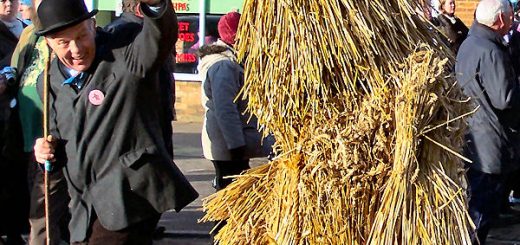The Ashton Gyst-Ale
The gyst-ale, or guising feast, was an annual festival of the town of Ashton-under-Lyne. It appears from the rental of Sir John de Assheton, compiled a.d. 1422, that a sum of twenty shillings was paid to him as lord of the manor for the privilege of holding this feast by its then conductors. The persons named in the roll as having paid three shillings and fourpence each are: — “Margret, that was the wife of Hobbe the Kynges (of Misrule); Hobbe Adamson; Roger the Baxter; Robert Somayster, Jenkyn of the Wode; and Thomas of Curtnal.” The meaning of the item gyst-ale is involved in some obscurity, and the custom itself is not mentioned by either Brand or Ellis in their collections of popular antiquities. Most probably the payments mentioned above were for the privilege of selling ale and other refreshments during the festivals held on the payment of the rents of the manor. These guisings were frequently held in the spring, most probably about Lady Day (25 March), when manorial rents were usually paid; and as the fields were manured with marl about the same period, the term marlings has been supposed to indicate the rough play, or marlocking which was then practised. This, however, must be a mistake, since the term relates to merry pranks, or pleasure gambols only, and has no connection with marl as a manure.
These gyst-ales, or guisings, once ranked amongst the principal festivals of Lancashire, and large sums of money were subscribed by all ranks of society in order that they might be celebrated with becoming splendour. The lord of the manor, the vicar of the parish, the farmer, and the operative, severally announced the sums they intended to give, and when the treasurer exclaimed “A largesse!” the crowd demanded “From whom?” and then due proclamation was made of the sum subscribed. The real amount, however, was seldom named, but it was announced that “Lord Johnson,” or some other equally distinguished person had contributed ” a portion of ten thousand pounds” towards the expenses of the feast.
After the subscription lists were closed an immense garland was prepared, which contained abundance of every flower in season, interspersed with a profusion of evergreens and ribbons of every shade and pattern. The framework of this garland was made of wood, to which hooks were affixed, and on these were suspended a large collection of watches, jewels, and silver articles borrowed from the richer residents in the town. On the day of the gyst this garland was borne through the principal streets and thoroughfares, attended by crowds of townspeople dressed in their best attire. These were formed into a procession by a master of the ceremonies, locally termed the King. Another principal attendant was the Fool, dressed in a grotesque cap, a hideous grinning mask, a long tail hanging behind, and a bell with which he commanded attention when announcements were to be made. In an early period of these guisings the fool was usually mounted on a hobby-horse, and indulged in grotesque pranks at he passed along. Hence we obtained the term “hob-riding,” and more recently the proverbial expression of “riding one’s hobby to death.”
Lancashire Legends (1873) by John Harland & T T Wilkinson




Recent Comments